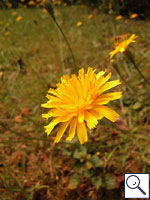|
||||||
|
LEONTODON. Hawkbits. [Asteraceae] |
|
|
Five of species of Leontodon are recorded in Britain. These include the native Autumn Hawkbit (L. autumnalis), Rough Hawkbit (L. hispidus) and Lesser Hawkbit (L. saxatilis). Leontodon autumnalis is treated as Scorzoneroides autumnalis by Stace (2010). The BSBI provide a downloadable plant crib for Leontodon. Eleven or twelve miners are recorded on Leontodon. The tortricid Cnephasia conspersana is recorded as a seed / shoot-feeder on Leontodon in Britain. A key to the European miners recorded on Leontodon is provided in Bladmineerders van Europa. |
|
Key for the identification of the known mines of British |
1a > Stem miner: An external stem mine with frass in two rows of disconnected strips. Pupation in stem at end of mine (Spencer, 1972b: 25; Spencer, 1976: 61 (fig. 63B), 65-6). |
|
Ophiomyia heringi Stary, 1930 [Diptera: Agromyzidae]. |
1b > Leaf-miner: Mine primarily associated with mid-rib. |
1c > Leaf-miner: Mine not primarily associated with mid-rib. |
2a> Leaf-miner: A distinctive mine primarily above mid-rib, with irregular short lateral offshoots into leaf blade. Pupation external (Spencer, 1972: 51 (fig. 172), 55; Spencer, 1976: 270, 271 (fig. 486)). Branched, whitish, upper-surface corridor; main axis overlying the midrib; side branches overlying the main lateral veins. (In Campanula and Phyteuma the mine is much less branched, sometimes nothing more than a corridor on top of the midrib). Frass in rather long strings. Usually the mines begins as a long and narrow, shallow, tortuous lower-surface corridor that ends upon the midrib but otherwise is not associated with the leaf venation. Often this initial corridor is filled with callus, and then even less conspicuous. Pupation outside the mine. A linear mine on the upper surface, usually following the midrib and showing side branches along the veins. The frass is in strings. |
|
Liriomyza strigata (Meigen, 1830) [Diptera: Agromyzidae]. |
2b > Leaf-miner: A whitish blotch-mine along the mid-rib, with lateral offshoots into the leaf blade. Pupation at base of leaf in petiole (Spencer, 1972b: 25). Broad corridor overlying the midrib, with short excursion into the blade, mainly in its basal part. Frass concentrated in the basal part of the mine, corridors almost free from frass. Pupation in the mine, also in the basal part. |
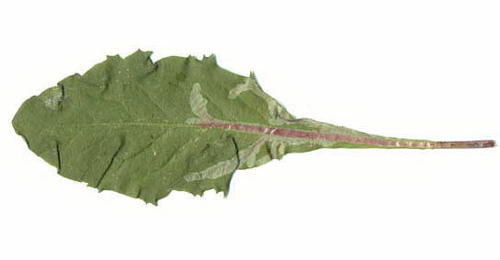 Mine of Ophiomyia pulicaria on Taraxacum officinale Image: © Willem Ellis (Bladmineerders van Europa) |
|
Ophiomyia pulicaria (Meigen, 1830) [Diptera: Agromyzidae]. |
2c > Leaf-miner: A white mine along mid-rib, with offshoots into leaf blade. Pupation internal at base of mid-rib. In Asteraceae the larva mostly lives as a borer in the midrib of the leaves. From there short corridors are made into the blade. Also a corridor can be made overlying the midrib. In Euphorbia a small mine is made in the bracts of the inflorescence. The final mine strongly resembles the one of Liriomyza strigata, but the branches are vritually free from frass; this is acccumulated in the resting place of the larva, in the base of the midrib. There also pupation takes place. Forms a mine along the midrib and has feeding spurs into the leaf. Pupation is in the mine at the base of the midrib. |
|
Ophiomyia beckeri (Hendel, 1923) [Diptera: Agromyzidae]. |
3a > Leaf-miner: A narrow, whitish linear mine. Pupation internal (Spencer, 1976: 416). Upper-surface, less often lower-surface corridor. Frass in isolated grains. Puparium within the mine, usually at the lower surface. |
|
Chromatomyia farfarella (Hendel, 1935) [Diptera: Agromyzidae]. |
3b > Leaf-miner: Mine linear, whitish, both upper and lower surface. Pupation internal, at the end of the mine with the anterior spiracles projecting through the epidermis (Spencer, 1976: 433). Upper-surface, less often lower-surface corridor. Frass in isolated grains. Pupation within the mine, usually in a lower-surface puparial chamber. A long whitish upper surface corridor, which eventually goes lower surface. |
|
Chromatomyia
horticola (Goureau, 1851) [Diptera: Agromyzidae] |
3c > Leaf-miner: A small somewhat irregular, elongate blotch (Spencer, 1972b: 57; Spencer, 1976: 273 (fig. 491), 274). Elongated upper-surfcace blotch with fairly little frass in loose grains. Pupation outside the mine; exit slit in upper epidermis. |
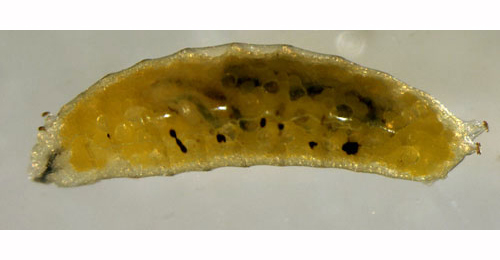 Liriomyza taraxaci larva, dorsal Image: © Willem Ellis (Bladmineerders van Europa) |
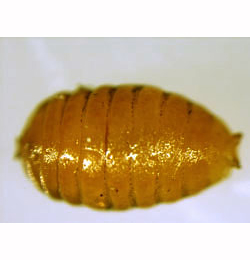 Liriomyza taraxaci puparium Image: © Willem Ellis (Bladmineerders van Europa) |
|
Liriomyza taraxaci Hering, 1927 [Diptera: Agromyzidae]. |
3d > Leaf-miner: Egg is laid beneath the epidermis on the upper leaf surface. Larva mines in basal leaves. Pupation internal (Spencer, 1976: 74). Little branched corridors, radiating from the leaf base, often deep in the plant tissue. The larva can migrate from one leaf to the other through the petioles. Frass concentrated in the lowest, basal part of the mine; there also the pupation takes place. |
|
Ophiomyia pinguis (Fallén, 1820) [Diptera: Agromyzidae]. |
3e > Larva mining both lower and upper surface, unusually long, linear, conspicuously broad, frequently largely on the underside of the leaf. Pupation external (Spencer, 1972b: 76 (fig. 251); Spencer, 1976: 445 (fig. 780), 446). Corridor mine. The first part consists of a very long and narrow lower-surface corridor; the mine is quite shollow here, and often inconspicuous. The second part is upper-surface, uusally much shorter, and widens abruptly. Pupation outside the mine. |
|
Phytomyza marginella Fallén, 1823 [Diptera: Agromyzidae]. |
3f > Leaf-miner: The mine begins with a very narrow full depth corridor, that ends upon the midrib. Subsequently a broad corridor, or rather an elongated blotch, is made overlying the midrib; from here broad, lobe-like extensions are made into the blade. Frass in discrete grains. Secondary feeding lines conspicuous. The larva is capable of leaving the mine and restarting in a new leaf, in which case the association with the midrib may be lost. Pupation after vacation of the mine. |
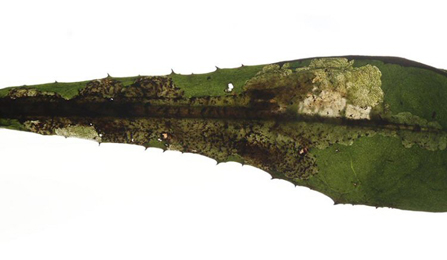 Mine of Trypeta immaculata on Taraxacum Image: Rob Edmunds (British leafminers) |
|
Trypeta immaculata (Macquart, 1835) [Diptera: Tephritidae]. |
3g > Leaf-miner: The mine begins in the midrib, especially in a lower leaf, extending into the leaf disc, branching irregularly or pinnately, may also locally be blotch like. The mine is brown and very transparent. Sides very irregularly eaten out. Frass loosely dispersed or in a loose central line, buy may also be pressed against the sides of the corridor. The larva may also leave the mine and restart elsewhere. |
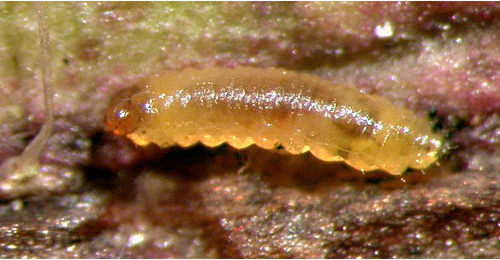 Orthochaetes setiger larva, dorsal Image: © Jean-Yves Baugnée (Bladmineerders van Europa) |
|
Orthochaetes setiger (Beck, 1817) [Coleoptera: Curculionidae]. |
| Last updated 05-Jul-2019 Brian Pitkin | ||

